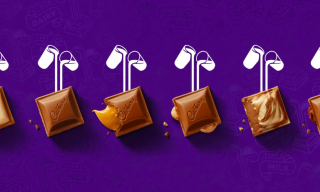Conjure an image of a bold creative campaign or a brave brand comms move. You know the type; they either make you wince at a subject matter that’s veered dangerously close to the line of bad taste (but not so much to force X to have a palpable meltdown) or a brand pops up in a domain it has absolutely zero right to play in but, somehow, it just works so damn beautifully.
You don’t need to be Mystic Meg (look her up, Gen Z) or Paul the Octopus (RIP) to predict the owner of said “brave” move isn’t the successful 80-year-old homewares brand that’s been a stalwart of the market for generations. Of course, it’s the new industry kid on the block, looking to get as many eyeballs on their slightly more eco and premium-priced products as possible, with a punch to the gut and a euphoric feeling of:
“Finally! Someone who understands how much millennials want to decorate their homes like a knock-off Soho House.”
The question is, why?
No, not why are millennials obsessed with Soho House (we’re basic, deal with it).
Why is brand boldness and brave marketing as synonymous with start-ups with bags full of sass and a shoestring budget as Oatly is with shouty billboards?
The latest episode of Jon Evans’ brilliant Uncensored CMO podcast features Gymbox brand director Rory McEntee, formerly of Paddy Power, Everyman Cinema and Papa Johns fame. Both uncover the winning principles of a challenger brand attitude to create cut-through marketing on little-to-no budget and a “seek forgiveness, not permission” mentality. While listening, it struck me that it’s absolutely batshit that brands simply “outgrow” the foundational tenets of highly creative, innovative, and cost-effective marketing.
The constant push for an unstoppable idea. A determination to stand out in a sea of competitor-set sameness. A new way of doing things that’s not simply: “A bit like last year ‘cos that worked well. Oh, but with less budget, obvs.”
Yawn, yawn, yawn.
If you’re a mature brand, arguably you’re in a bigger competitor set. You won’t be the first to market any more. Or even that different from others in the market. You’ll have competition snapping at your heels and your well-carved market share to boot.
So.
Surely.
This is exactly the time to be brave, and not play it safe.
When you look at how they market themselves, how different really does one mainstream car brand feel to the next? One hotel chain to the other? Do we really have to just play on product benefits that should be downright expected of the things you’re buying anyway (looking at you, Premier Inn and your good nights’ sleep)?
Challenging the challengers
OK, so clearly we’re not just going to risk all our hard-earned brand equity, reputation and, let’s face it, healthier budget on one whacking great slap-you-round-the-face-and-leave-you-thinking-WTF, challenger-brand-esque annual campaign.
But that’s not the part of challenger brand marketing we need to retain.
It’s the test and learn; the try it and see what happens. The boldness to know that whatever you do, you will learn something, and whatever you do also doesn’t have to break the bank in one fell swoop. There will – and should be – other campaigns that follow and eclipse something that might not work. But that brave idea might also just be brilliant. Unstoppable, even.
That’s not to say we throw caution to the wind and machine-gun out a series of hastily brainstormed flash mobs, guerilla-style marketing, AI content pieces and hope for the best. There needs to be a strategy to link the component parts of the test, learn and move cycle. But you can still have fun with it. Just ask Paddy Power and the strategic intent to position gambling as entertainment and gain rather than expense and loss. Whether you agree with the promotion of gambling or not, you can’t argue that it shines through everything they did, do and continue to do… and very bravely (the wincing, close to-the-line of decency kind) most of the time.
So why do brands become less brave as they grow?
Budgets are bigger as you grow and, therefore, are more scrutinized than ever. Concurrently, they’re also historically small as the industry continues to emerge from the pandemic, the recession and the rest.
Add to the fact that marketing budgets are repeatedly pegged as the “biggest most expendable budget line item,” and things feel tense. Basically, use it (well) or lose it. Hell, even if it’s used well, it still might go, depending on other industry and market forces. Or how confused the CEO is.
This is where the fear of loss starts to set in.
And that can trundle on being a bit less brave.
We get a bit bigger, and then shareholders enter the mix. Everything gets a little bit more antsy when it comes to not cocking it all up. Budgets scrutinized more. Brave signed off by legal less.
And then, what’s the opposite of brave? You’re that.
Time to de-risk brave
This is where education comes in. And probably more CMOs on boards required.
Side note: just 2.6% of board positions are held by marketers, also according to Jon and Chris Burggraeve in the 17 July episode of the aforementioned Uncensored CMO podcast. It’s no wonder marketing is seen as an expendable budget item with little business value.
Anyway, back to de-risking brave. Fact is, even shareholders are human.
Danny Kahnmeman’s loss aversion theory tells us that losses loom larger than gains. The more we have to lose, the more aversion to risking losing what we have.
So we play it safe. Rather than looking our millennial friends in the eyes and telling them they don’t just need to paint their walls Soho House Green, but they can go all in, buy the chaise longue, the swanky lighting and ban laptops in certain areas of your house if you want… we don’t. We hedge our bets and try to appeal to all millennials just a little bit, not just those who’ll love us wholeheartedly (and with the whole of their wallet) and our member-club-loving ways.
We protect at all odds and aim to please all customers all the time, and we end up pleasing no one. Because being bland pleases no one. Being bold, on the other hand, turns your fans into brand advocates. Knowing your audience inside out and going in hard with this group surely feels imperative to lead the market.
Speaking the sweet language of finance
So far so good, but for this to work, and budgets for brave campaigns to be signed off, you have to make this point in a language the well-set board and risk-averse shareholders will understand… a financial one.
Put it this way, we can work very hard to gain a lot of new customers on a short-term basis through trying to please everyone. Ultimately, though, we will lose them on price to our nearest same-same competitor the minute they have a better Bank Holiday sale.
Or we can invest in developing fewer, long-term brand fans for life who will ride out price increases with inflation and hold longer-term value with repeat purchase. And that’s before we get into the power of peer-to-peer advocacy or the captive audience / NPD testing benefits of long-term loyal audiences. It’s a simple cost per acquisition vs lifetime value of the customer conversation. And now we’re talking.
Originally published on The DRUM.



